The Skylake Core i3 (51W) CPU Review: i3-6320, i3-6300 and i3-6100 Tested
by Ian Cutress on August 8, 2016 9:00 AM ESTMiddle-Earth: Shadow of Mordor
The final title in our testing is another battle of system performance with the open world action-adventure title, Shadow of Mordor. Produced by Monolith using the LithTech Jupiter EX engine and numerous detail add-ons, SoM goes for detail and complexity to a large extent, despite having to be cut down from the original plans. The main story itself was written by the same writer as Red Dead Redemption, and it received Zero Punctuation’s Game of The Year in 2014.
For testing purposes, SoM gives a dynamic screen resolution setting, allowing us to render at high resolutions that are then scaled down to the monitor. As a result, we get several tests using the in-game benchmark, taking results as the average and minimum frame rates. Minimum frame rate results can be found in Bench.
For this test we used the following settings with our graphics cards:
| Shadow of Mordor Settings | |||
| Resolution | Quality | ||
| Low GPU | Integrated Graphics | 1280x720 | Low |
| ASUS R7 240 1GB DDR3 | |||
| Medium GPU | MSI GTX 770 Lightning 2GB | 1920x1080 | Ultra |
| MSI R9 285 Gaming 2G | |||
| High GPU | ASUS GTX 980 Strix 4GB | 1920x1080 3840x2160 |
Ultra Ultra |
| MSI R9 290X Gaming 4G | |||
Integrated Graphics
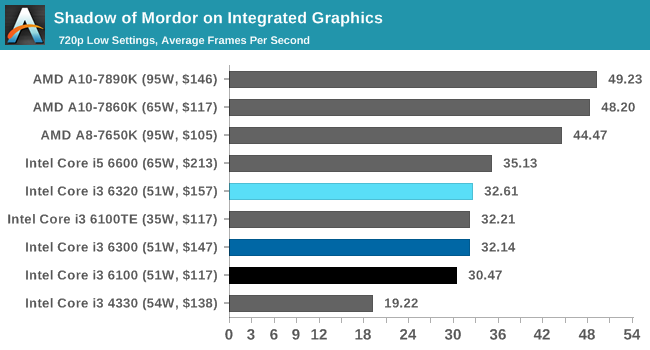
As with the other IGP tests, the APU solution gets significantly better results.
Discrete Graphics
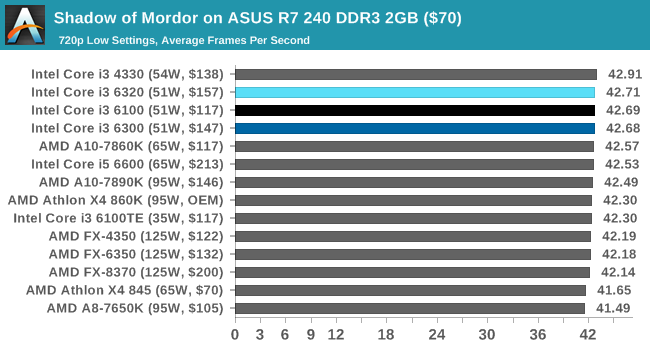
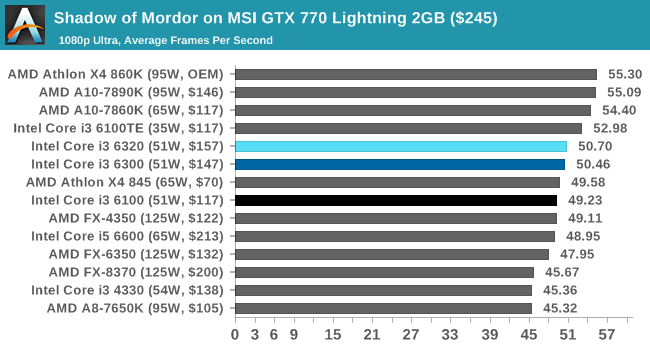

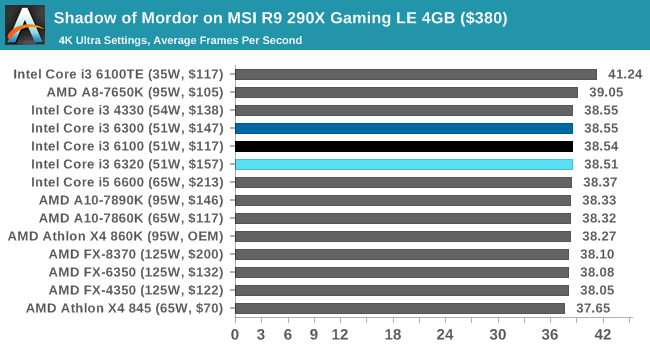
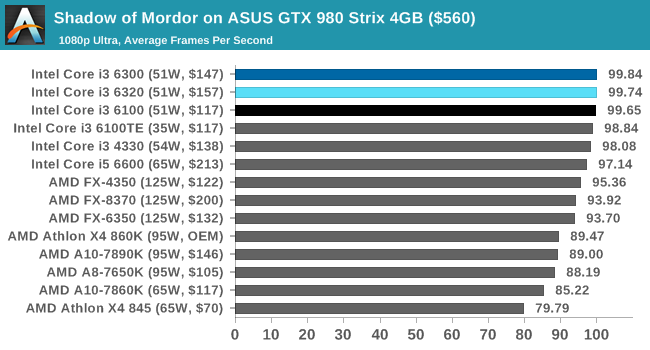
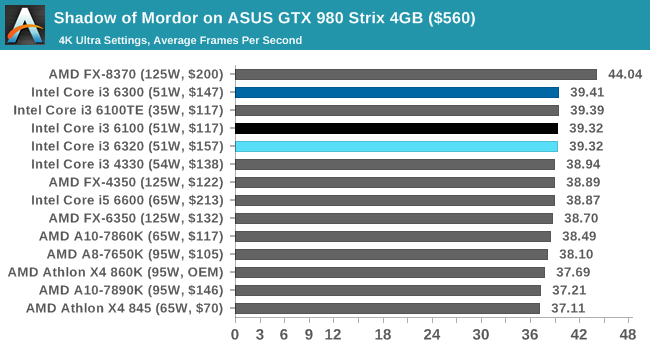
SoM is our most CPU agnostic benchmark of the set, such that as you increase the GPU power and the resolution, the CPU matters less to the performance. This is why at 4K Ultra, with both the AMD and NVIDIA discrete GPUs, the $70 CPU from AMD is within 2-3% for average frame rates.
However, it should be noted that the CPU power matters more when (a) an AMD discrete GPU is being used, or (b) lower resolutions. In both cases, the AMD FX CPUs are more likely to match up with Intel's Core i3, which sit at the top of the pack.











94 Comments
View All Comments
Morawka - Monday, August 8, 2016 - link
It's still suprising to see it on a low end CPU. i didnt know the i3's had ECC, now i'm thinking of building a FREENAS box off of one of theseSamus - Tuesday, August 9, 2016 - link
You'd be surprised how many servers actually ship with i3's...those HP ML10's are incredibly common and I've seen a number of Lenovo SMB servers run i3's.The i3 is more than adequate for most small business servers unless they plan to run Hyper-V. Most other CPU intense services are cloud-based now (I personally think a business is crazy to maintain their own exchange server these days when Microsoft offers a $4/month/mailbox turn-key solution)
Basically all servers do now is run the domain and a few basic services like file sharing and routing. SQL, Exchange, even Hyper-V are all inexpensive Azure\Office365 services. It really comes down to who costs more, your IT guy, or Microsoft. Odds are, the IT guy. Unfortunate because I am one.
jardows2 - Monday, August 8, 2016 - link
Low end consumer CPU's. Intel likes the product segmentation between Xeon's and i5/i7. This is also why Intel forced the use of the "c" series chipsets for the Xeon processors. a Xeon E3-1240 v5 is about $30.00 cheaper than an i7 6700, with a higher base frequency, but slightly lower turbo frequency.Of course, this helps people who are wanting server grade, but only need low end processing power. A Pentium or an i3 would be a great home server chip, but i5 or i7 overkill. If you are wanting to use a higher-end production computer with ECC, you probably are looking at higher-end processors than i5 or i7 anyway.
However, AMD includes the support in all their AM3+ processors, and I believe in all their FM2 processors as well. Not every motherboard supports it.
sheh - Monday, August 8, 2016 - link
Yes, I was referring to non-server CPUs.But why is it on the i3? Not that I mind, but the surprising aspect and the problem is that it's not on i5 and i7.
Black Obsidian - Monday, August 8, 2016 - link
jardows2 covers that in his/her product segmentation reference.If you want ECC on the low end, Intel is happy to sell you an i3. If your needs are any higher, Intel wants to push you towards a Xeon (and C-series chipset), which IIRC are higher-margin parts than the i5 and i7, and happen to have gone through additional server-related validation.
satai - Monday, August 8, 2016 - link
I understand this concept but I still don't get why there are cheap ECC enabled i3s instead of more expensive (but still cheaper than 4C Xeons) dual-core Xeons...extide - Monday, August 8, 2016 - link
Yeah, that is kinda weird, you would think Intel would do that, and create even more segmentation, which is something they definitely tend to like to do.rhysiam - Monday, August 8, 2016 - link
My guess would be (and full disclosure... this an educated guess): at some point the market becomes too niche and the higher profit margins get lost to the additional costs of segmenting product lines, keeping different lines in stock, etc. The cheapest Xeon quad core on Newegg is already only $90 more than the cheapest i3. How much more could Intel actually charge for a dual core Xeon over the i3, the only benefit of which is ECC? Then they'd have to maintain a whole new product line, manage stock levels, etc. My guess is that for the relatively small number of customers pairing a dual core with ECC memory, it's just more trouble than it's worth.satai - Tuesday, August 9, 2016 - link
Thet sounds like a believable explanation.DanNeely - Monday, August 8, 2016 - link
What exactly is the point of the Core i3-6098P supposed to be? Compared to the equally priced I3-6100, it's slower, has a weaker GPU, and a higher TDP. On paper I can't see any reason to buy the former instead of the latter?